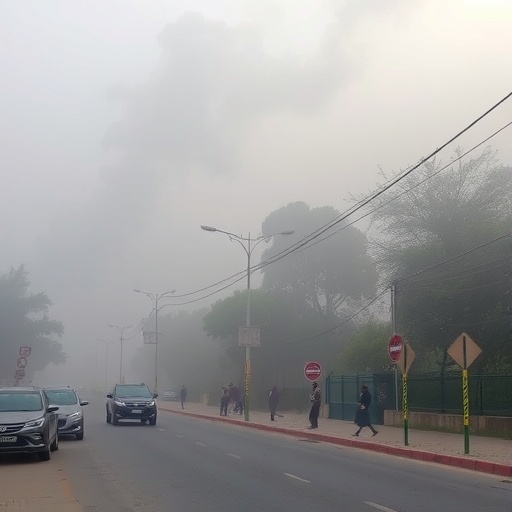Recent studies have brought to light the complex relationship between air quality and meteorological conditions, with particular emphasis on fine particulate matter known as PM2.5. An extensive study by researchers Zeb, Nasir, and Alam has focused on the PM2.5 pollution levels across the four capital cities of Pakistan, which has become increasingly relevant in discussions about public health and environmental sustainability. The research was motivated by the alarming rise in air pollution in urban areas, and how this could correlate with changes in weather patterns and climatic conditions over time.
The study meticulously gathers and analyzes meteorological data—integrating temperature, humidity, wind speed, and atmospheric pressure—aimed at uncovering the seasonal variations in PM2.5 concentration. The scientists deployed advanced analytical methods to uncover correlations between these meteorological factors and concentrations of fine particulate matter. With specific reference to the four capital cities, the research contextualizes PM2.5 trends within the unique geographical and climatic characteristics of each region. The results elucidate a pressing narrative: heightened PM2.5 levels correspond remarkably with specific meteorological phenomena, further complicating the interplay of urban air quality and climate.
For cities like Islamabad, Lahore, Karachi, and Peshawar, which experience distinct atmospheric conditions, the findings revealed how local meteorology significantly dictates pollution levels. For instance, stagnant air conditions prevalent in the winter months often lead to an accumulation of particulate matter, resulting in dangerously high PM2.5 concentrations. The study not only highlights immediate health risks but also raises questions about long-term public health strategies in these urban environments.
Another critical aspect of the research focuses on how meteorological parameters—such as temperature inversions and humidity—ensure that PM2.5 remains suspended in the air for extended periods. This phenomenon is especially troubling as prolonged exposure to high PM2.5 levels can exacerbate respiratory conditions and cardiovascular diseases, particularly in vulnerable populations. Such data provide crucial insights for policymakers and urban planners who are tasked with designing interventions to mitigate pollution levels.
Furthermore, the analysis extended to investigating daily versus seasonal variations in PM2.5 concentrations, establishing a compelling narrative of how weather patterns dictate pollution spikes. This analysis demonstrates the need for real-time monitoring and forecasting of air quality, which could serve as an essential component in developing timely public health advisories to protect citizens from adverse health outcomes during peak pollution events.
Understanding the sources of PM2.5 pollution in the context of these meteorological interactions is imperative for comprehensive environmental management. The study meticulously categorized primary sources of particulate matter, including vehicular emissions, industrial discharge, and biomass burning. The researchers argue that recognizing these pathways allows for a more nuanced approach to regulatory frameworks and pollution mitigation strategies tailored to the distinct profiles of each city.
The implications of the research extend beyond immediate pollution concerns. With the growing discourse on climate change and its multifaceted impacts on urban air quality, the findings present an urgent call for integrated climate and healthcare policies. The linking of air pollution epidemiology with meteorological data not only enhances the scientific understanding but also provides a roadmap for future research focused on predictive modeling and risk assessment.
Importantly, the study underlines the ethical dimensions of environmental health research. Public health officials and advocates must be informed not only by scientific data but also by the socio-economic realities that affect vulnerable populations disproportionately affected by air quality issues. The equity implications of higher PM2.5 exposure in low-income areas enrich the research, providing an additional layer of complexity and urgency to these findings.
This research will undeniably serve as a benchmark for future studies examining air quality in developing countries, paving the way for innovative solutions and collaborative approaches to tackle pollution. By illuminating the dynamic interplay between meteorological parameters and PM2.5 levels, Zeb, Nasir, and Alam contribute significantly to the body of knowledge essential for implementing effective public health and environmental policies.
In conclusion, as urban centers across Pakistan grapple with increasing pollution levels, this crucial research raises awareness about the underlying factors that exacerbate air quality issues. By interlinking meteorological data with pollution metrics, the researchers provide a crucial lens through which to address and mitigate the impacts of PM2.5 pollution. As cities prepare to respond to the dual challenges of urbanization and climate change, this type of research becomes not just informative but transformative, equipping stakeholders with the knowledge required for active and informed action.
The critical insights offered by this study cannot be overstated; they underscore a pressing need for integration between environmental regulations and healthcare strategies to curb the detrimental impacts of PM2.5 pollutants in urban areas. The narratives established within the research provide a robust foundation for advocating for cleaner air policies in Pakistan and other regions facing similar challenges.
This timely investigation represents an urgent call to action, advocating for increased awareness and immediate responses to air pollution. As we confront the reality of climate change and its adversities, the knowledge generated from such studies lays the groundwork for sustainable, healthy environments that benefit not only current inhabitants but also future generations.
Subject of Research: PM2.5 pollution and its correlation with meteorological parameters over the four capital cities of Pakistan.
Article Title: PM2.5 pollution and its correlation with meteorological parameters over the four capital cities of Pakistan.
Article References:
Zeb, B., Nasir, J., Alam, K. et al. PM2.5 pollution and its correlation with meteorological parameters over the four capital cities of Pakistan.
Environ Monit Assess 197, 1237 (2025). https://doi.org/10.1007/s10661-025-14691-2
Image Credits: AI Generated
DOI: 10.1007/s10661-025-14691-2
Keywords: PM2.5, air quality, meteorological parameters, public health, urban pollution, climate change, environmental policy.




